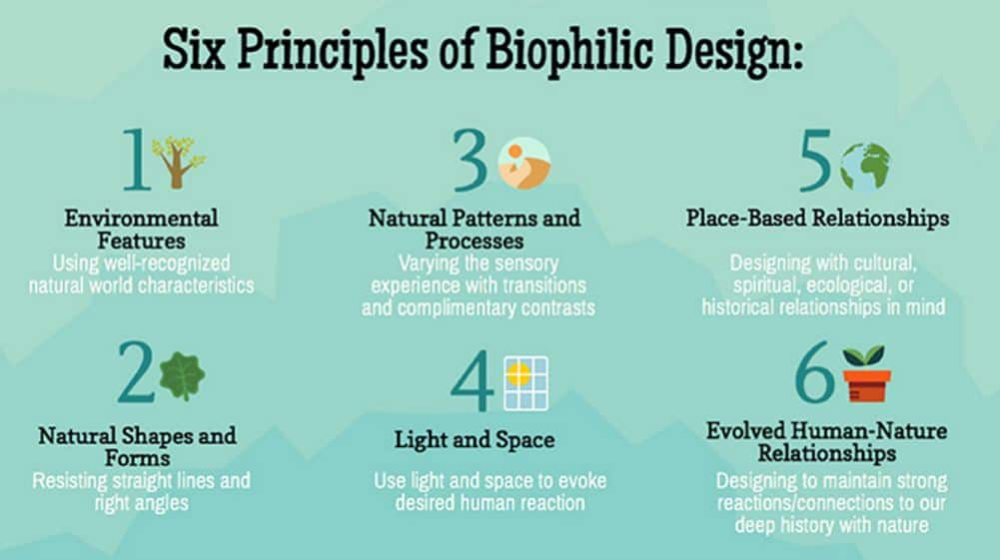How Does Architecture Respond To The Principles Of Biophilic Design?

What is biophilic design and how does it affect our well-being? Biophilic design is a concept that emphasizes the importance of incorporating nature into our built environments, from our homes to our workplaces. The term "biophilia" means "love of life" or "love of living systems." The idea is that by creating spaces that mimic natural environments, we can create a sense of calm and well-being for those who use them.
Here are some of the key benefits of biophilic design:
Improved Mood
Studies have shown that being in nature can have a positive impact on our mood. By incorporating natural elements into our built environments, we can create spaces that help to reduce stress and anxiety and promote feelings of relaxation and well-being. For example, a room with large windows that allow natural light to flood in can create a sense of openness and connection to the outdoors.
Increased Productivity
Research has also shown that people who work in environments with natural elements, such as plants or natural materials, tend to be more productive and creative. For example, a study conducted by researchers in the Netherlands found that workers in offices with plants were more productive and had lower levels of stress than those in offices without plants.
Better Health
The benefits of nature go beyond just improving mood and productivity. There is also evidence to suggest that being in natural environments can have a positive impact on our physical health. For example, spending time in nature has been shown to help lower blood pressure, improve immune function, and reduce the risk of certain health conditions such as heart disease.
Reduced Noise Pollution
Another benefit of biophilic design is that it can help to reduce noise pollution. By incorporating natural elements such as plants or water features into our built environments, we can create a more calming and peaceful atmosphere that helps to block out unwanted noise. This can be particularly beneficial in noisy urban environments.
Improved Air Quality
Plants are natural air purifiers, and by incorporating them into our built environments, we can improve indoor air quality. This can have a positive impact on our health, as poor air quality can lead to a range of respiratory problems. In addition to improving air quality, plants can also help to regulate humidity levels, creating a more comfortable indoor environment.
Increased Connection to Nature
Finally, biophilic design can help to foster a sense of connection to the natural world. By incorporating natural elements into our built environments, we are reminded of the beauty and wonder of the natural world. This can help to create a sense of awe and reverence for nature, which can in turn lead to a greater appreciation for the environment and a desire to protect it for future generations.
Frequently Asked Questions
Can biophilic design be incorporated into any space?
Yes! Biophilic design can be incorporated into any space, from a small apartment to a large office building. The key is to find ways to incorporate natural elements such as plants, natural materials, and water features into the space in a way that feels natural and unobtrusive.
What are some examples of biophilic design?
Some examples of biophilic design include:
- Using natural materials, such as wood or stone, in the construction of a building
- Incorporating plants into the design of a space
- Using natural lighting to create a sense of openness and connection to the outdoors
- Incorporating water features, such as fountains or indoor ponds, into the design of a space
How can I incorporate biophilic design into my home?
There are many ways to incorporate biophilic design into your home. Some ideas include:
- Using natural materials, such as wood or stone, in the construction of your home
- Incorporating plants into your home decor
- Using natural lighting to create a sense of openness and connection to the outdoors
- Installing a water feature, such as a pond or fountain, in your backyard
What are the benefits of incorporating biophilic design into my home?
The benefits of incorporating biophilic design into your home are numerous. You may experience improved mood, increased productivity, better physical health, and a greater sense of connection to the natural world. Additionally, a home that incorporates natural elements can be more aesthetically pleasing and may even increase in value over time.
In conclusion, biophilic design is a concept that is gaining popularity as more and more people recognize the benefits of incorporating nature into our built environments. Whether you are designing a small apartment or a large office building, there are many ways to incorporate natural elements into your space in a way that promotes well-being and connection to the natural world. So why not give it a try?



Post a Comment for "How Does Architecture Respond To The Principles Of Biophilic Design?"